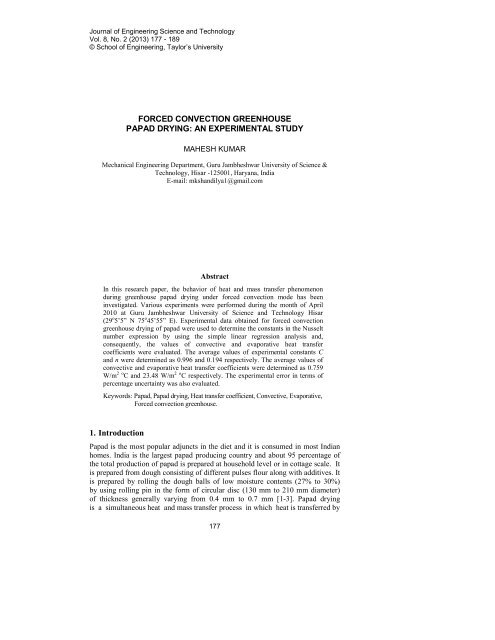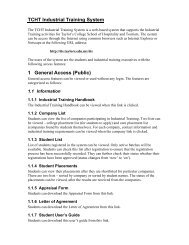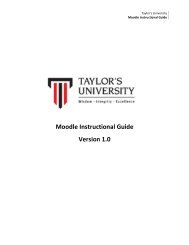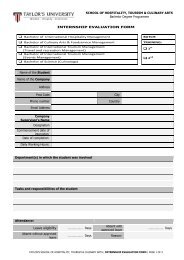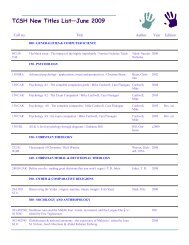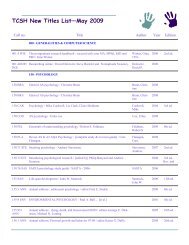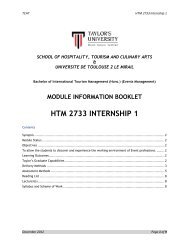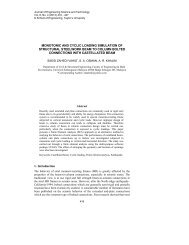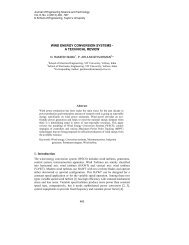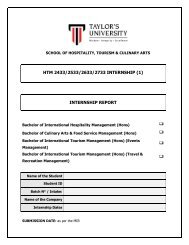Forced convection greenhouse papad drying - JESTEC
Forced convection greenhouse papad drying - JESTEC
Forced convection greenhouse papad drying - JESTEC
Create successful ePaper yourself
Turn your PDF publications into a flip-book with our unique Google optimized e-Paper software.
Journal of Engineering Science and TechnologyVol. 8, No. 2 (2013) 177 - 189© School of Engineering, Taylor’s UniversityFORCED CONVECTION GREENHOUSEPAPAD DRYING: AN EXPERIMENTAL STUDYMAHESH KUMARMechanical Engineering Department, Guru Jambheshwar University of Science &Technology, Hisar -125001, Haryana, IndiaE-mail: mkshandilya1@gmail.comAbstractIn this research paper, the behavior of heat and mass transfer phenomenonduring <strong>greenhouse</strong> <strong>papad</strong> <strong>drying</strong> under forced <strong>convection</strong> mode has beeninvestigated. Various experiments were performed during the month of April2010 at Guru Jambheshwar University of Science and Technology Hisar(29 o 5’5” N 75 o 45’55” E). Experimental data obtained for forced <strong>convection</strong><strong>greenhouse</strong> <strong>drying</strong> of <strong>papad</strong> were used to determine the constants in the Nusseltnumber expression by using the simple linear regression analysis and,consequently, the values of convective and evaporative heat transfercoefficients were evaluated. The average values of experimental constants Cand n were determined as 0.996 and 0.194 respectively. The average values ofconvective and evaporative heat transfer coefficients were determined as 0.759W/m 2 o C and 23.48 W/m 2 o C respectively. The experimental error in terms ofpercentage uncertainty was also evaluated.Keywords: Papad, Papad <strong>drying</strong>, Heat transfer coefficient, Convective, Evaporative,<strong>Forced</strong> <strong>convection</strong> <strong>greenhouse</strong>.1. IntroductionPapad is the most popular adjuncts in the diet and it is consumed in most Indianhomes. India is the largest <strong>papad</strong> producing country and about 95 percentage ofthe total production of <strong>papad</strong> is prepared at household level or in cottage scale. Itis prepared from dough consisting of different pulses flour along with additives. Itis prepared by rolling the dough balls of low moisture contents (27% to 30%)by using rolling pin in the form of circular disc (130 mm to 210 mm diameter)of thickness generally varying from 0.4 mm to 0.7 mm [1-3]. Papad <strong>drying</strong>is a simultaneous heat and mass transfer process in which heat is transferred by177
178 M. KumarNomenclaturesA t Area of tray, m 2C Experimental constantC v Specific heat of humid air, J/kg o Cg Acceleration due to gravity, m/s 2h c Convective heat transfer coefficient, W/m 2 o Ch c,av Average convective heat transfer coefficient, W/m 2 o Ch e Evaporative heat transfer coefficient, W/m 2 o Ch e,av Average evaporative heat transfer coefficient, W/m 2 o CK v Thermal conductivity of humid air, W/m o Cm ev Mass evaporated, kgN Number of observations in each setN o Number of setsNu Nusselt number = h c X/K vn Experimental constantP(T) Partial vapor pressure at temperature T, N/m 2Pr Prandtl number = µ v C v /K vQ &eRate of heat utilized to evaporate moisture, J/m 2 sRe Reynolds number = ρ v V X/µ vT e Temperature just above the <strong>papad</strong> surface, o CT g Greenhouse temperature, o CT p Temperature of <strong>papad</strong> surface, o Ct Time, sV Air velocity inside <strong>greenhouse</strong>, m/sX Characteristic dimension, mGreek Symbolsβ Coefficient of volumetric expansion (K -1 )γ Relative humidity (%)λ Latent heat of vaporization, J/kgµ v Dynamic viscosity of humid air, N s/m 2ρ v Density of humid air, kg/m 3σ Standard deviation<strong>convection</strong> and radiation to <strong>papad</strong>-air interface and by conduction to the interiorof <strong>papad</strong>. Water is transferred by diffusion from inside the <strong>papad</strong> to <strong>papad</strong>-airinterface and from the interface to the air stream by <strong>convection</strong>. Thus, <strong>papad</strong><strong>drying</strong> involves removal of moisture in order to preserve it.Open sun <strong>drying</strong> is the most primitive (traditional) method of <strong>papad</strong> <strong>drying</strong>.However, this traditional method of <strong>drying</strong> suffers from high product losses dueto inadequate <strong>drying</strong>, fungal growth, encroachments of insects, rodents, birds,and other contamination resulting in poor product quality. In spite of manydisadvantages, open sun <strong>drying</strong> is still practiced in places throughout the world.Although the hot air industrial driers are available to get the good quality of theproduct but they consume large amount of energy. The scarcity of fossil fuelswith their rising cost of production and environmental pollution emphasize theneed on the utilization of solar energy as an alternative source for lowtemperature <strong>drying</strong> applications, especially in the regions, where this source isJournal of Engineering Science and Technology April 2013, Vol. 8(2)
180 M. Kumar2. Materials and Methods2.1. Experimental set-up and instrumentationA roof type even span <strong>greenhouse</strong> of 1.2×0.8 m 2 effective floor area wasfabricated of PVC pipe and a UV film covering of 200 microns. The centralheight and the walls were maintained as 0.6 m and 0.4 m respectively. A fan of225 mm sweep diameter and 1340 rpm with a rated air velocity of 5 m/s wasprovided on the sidewall of the <strong>greenhouse</strong> for the forced <strong>convection</strong> experiments.A photograph of the experimental setup for <strong>greenhouse</strong> <strong>drying</strong> in the forced modeis shown in Fig. 1 and its schematic view is shown in Fig. 2.Fig. 1. Experimental Set-up of GreenhousePapad Drying under <strong>Forced</strong> Convection Mode.Fig. 2. Schematic View of GreenhousePapad <strong>drying</strong> under <strong>Forced</strong> Convection Mode.Journal of Engineering Science and Technology April 2013, Vol. 8(2)
<strong>Forced</strong> Convection Greenhouse Papad Drying: An Experimental Study 181A circular shaped wire mesh tray of diameter 0.180 m was used toaccommodate the <strong>papad</strong> for single layer <strong>drying</strong>. It was kept directly over thedigital weighing balance of 6 kg capacity (model TJ-6000, Scaletech, made inIndia) having a least count of 0.1 g. The <strong>papad</strong> surface temperature (T p ) and airtemperature at different locations were measured by calibrated copper-constantanthermocouples connected to a ten channel digital temperature indicator with aleast count of 0.1 o C (accuracy ±0.1%). The relative humidity, γ and thetemperature just above the <strong>papad</strong> surface, T e , were measured by a digitalhumidity/temperature meter (model Lutron-HT 3006, made in Taiwan). It had aleast count of 0.1% relative humidity (an accuracy of ±3% on the full scale rangeof 10 to 95% of RH) and 0.1 o C temperature (an accuracy of ± 0.8 o C on the fullscale range of 50 o C). The air velocity across the <strong>greenhouse</strong> section was measuredwith an electronic digital anemometer (model AM-4201, made in Taiwan). It hada least count of 0.1 m/s with an accuracy of ±2% on the full scale range of 0.2 to30.0 m/s.Calibration of thermocouplesCopper-constantan thermocouples connected to ten channel digital temperatureindicator were used to record the <strong>papad</strong> surface temperature and air temperature atdifferent locations. The thermocouples tend to deviate from the actual data after along period, so it is necessary to calibrate with respect to a standard thermometer,the ZEAL thermometer, which gives accurate readings.2.2. Sample preparation and experimental observationsPapad was freshly prepared by taking the flour of moong bean (Indian trade name- moong) and phaseolus mungo (Indian trade name - urad dal) mixed with 27.5%water content per kg of <strong>papad</strong> weight. The flour was purchased locally, and thatfraction of flour which passed through an eighty five mesh (180 microns) BritishStandard sieve was used for making <strong>papad</strong>. The dough was kneaded and rolled incircular shape of 0.7 mm thickness and 180 mm diameter with the help of pastryboardand pastry-roller. The freshly prepared <strong>papad</strong> of 23.5 g was used for eachrun of the forced <strong>convection</strong> <strong>greenhouse</strong> <strong>papad</strong> <strong>drying</strong>.Experiments were performed during the month of April 2010 at GuruJambheshwar University of Science and Technology Hisar (29 o 5’5” N 75 o 45’55”E). The orientation of the <strong>greenhouse</strong> during the experimentation was kept eastwestbecause sunlight availability is more in comparison to north-south.Experimental setup was located on the open floor of a three-floor building to havea good exposure to the solar radiation. Each observation was taken for <strong>papad</strong><strong>drying</strong> after half an hour time interval. The <strong>papad</strong> sample was kept in the wiremesh tray over the digital weighing balance. The moisture evaporated wascalculated by taking the difference of mass of <strong>papad</strong> between two consecutivereadings. The <strong>papad</strong> sample was dried till no variation in its mass was observed.In order to obtain accurate results, the above mentioned experimentationprocedure was repeated four times for each freshly prepared similar <strong>papad</strong> sampleof same size (i.e., 180 mm diameter and 0.7 mm thickness) on consecutive days atthe same timing. The initial mass of <strong>papad</strong> sample for each run of <strong>drying</strong> waskept constant (i.e., 23.5 g).Journal of Engineering Science and Technology April 2013, Vol. 8(2)
182 M. Kumar2.3. Thermal modelingThe convective heat transfer coefficient under forced <strong>convection</strong> can be definedas [3, 15, 16]:KX( RePr) nvc= C(1)heThe rate of heat utilized to evaporate moisture is given as [17]c[ P( T ) − γ P( T )]Q & = 0. 016h(2)peOn substituting h c from Eq. (1), Eq. (2) becomesn( Re ) [ P( T ) − γ P( T )]KvQ & e= 0.016 C PrpeX(3)The moisture evaporated is determined by dividing Eq. (3) by the latent heatof vaporization (λ) and multiplying the area of the <strong>papad</strong> <strong>drying</strong> tray (A t ) and timeinterval (t).mevQ&eKv= Att = 0.016 C PrλXλLet0 .016mZKXλ[ P( T ) − γ P( T )] A t Zvpe t=evC( ) nn( Re ) [ P( T ) − γ P( T )] A tp= RePr(5)Taking the logarithm of both sides of Eq. (5),⎡lnm ⎤ ev = lnC+ nln( RePr)(6)⎢⎣ Z ⎥⎦This is the form of a linear equation,Y = mX 0 + C 0(7)where⎡ mev⎤Y = ln ⎢ ⎥ ,⎣ Z ⎦m = n ,X 0 = ln( RePr), andC0 = lnCThus,CoC = eValues of m and C o in Eq. (7) are obtained by using the simple linearregression method by using the following formulaeet(4)Journal of Engineering Science and Technology April 2013, Vol. 8(2)
<strong>Forced</strong> Convection Greenhouse Papad Drying: An Experimental Study 183N ∑ X 0Y− ∑ X 0 ∑Ym =(8)22N ∑ X −and02( ∑ X )0∑ X 0 ∑Y− ∑ X 0 ∑ X 0YC 0 =(9)22N∑X −0( ∑ X )0Then the constant ‘ C ’ and exponent ‘ n ’ can be obtained from the aboveequations. The values of these constant were considered further to determine theconvective heat transfer coefficient. After knowing the convective heat transfercoefficient ( h c ), the evaporative heat transfer coefficient ( h e ) can also becalculated from Eq. (10) as follows [16]:( ) − γ P( T )⎡ P Tpe⎤he= 0 .016 hc⎢⎥(10)⎢⎣Tp−Te⎥⎦2.4. Physical properties of humid airThe following expressions were used for determining the values of the physicalproperties of humid air, such as specific heat ( C ), thermal conductivity ( K ),density ( ρ ), viscosity (vµ ), and partial vapor pressure, ( T )v−42Tiv−83P [3, 10, 15]:Cv= 999.2+ 0.1434Ti + 1.101×10 − 6.7581×10 Ti(11)−4K v = 0.0244 + 0.7673×10 T i(12)353.44ρ =(13)v( T + 273.15)i− 5 − 8v = 1.718×10 + 4.620×10 T iµ (14)⎡5144 ⎤P ( T ) = exp⎢25.317−(15)⎣where T = ( T + T ) 2ip( T + 273.15) ⎥ i ⎦ev2.5. Experimental errorThe experimental method used for determining the convective heat transfercoefficient is an indirect approach based on the mass of moisture evaporated fromthe <strong>papad</strong>. This indirect approach has a considerable degree of experimentaluncertainty in the estimated convective heat transfer coefficient. The experimentalerror was evaluated in terms of percentage uncertainty (internal + external) for themoisture evaporated. The following two equations were used for internaluncertainty [16-19]:Journal of Engineering Science and Technology April 2013, Vol. 8(2)
184 M. KumarUI2 2 21 + σ 2 + KσNσ= (16)No⎛ ⎞∑⎜X − X ⎟and σ =⎝ ⎠(17)N− 2Therefore, the percentage internal uncertainty was determined using thefollowing expression:% internal uncertainty = (U I /mean of the total observations) ×100 (18)For external uncertainty, the least counts of all the instruments used inmeasuring the observation data were considered.2.6. Computation techniqueThe average of <strong>papad</strong> surface temperature (T p ) and temperature above the <strong>papad</strong>surface (T e ) inside <strong>greenhouse</strong> were calculated at half an hour time interval forcorresponding moisture evaporated. The air velocity across the <strong>greenhouse</strong>section during the forced <strong>convection</strong> <strong>drying</strong> mode was measured with ananemometer. The physical properties of humid air were evaluated for the meantemperature (T i ) of T p and T e by using Eqs. (11) to (15). These physical propertiesof humid air and velocity of air were used for determining the values of theReynolds number (Re) and Prandtl number (Pr). The values of C and n in Eq. (1)were determined by simple linear regression analysis, and then the values ofconvective heat transfer coefficient (h c ) were calculated at the increment of everyhalf an hour of observation. The evaporative heat transfer coefficients wereevaluated by using Eq. (10).3. Results and DiscussionThe experimental data obtained for <strong>papad</strong> <strong>drying</strong> under forced <strong>convection</strong><strong>greenhouse</strong> mode are given in Tables 1(a) to (d).The data given in Tables 1(a) to (d) were used to determine the values ofconstant C and exponent n in the Nusselt number expression by simple linearregression analysis. Then the values of the constant C and exponent n were usedfurther for determining the values of the convective heat transfer coefficient byEq. (1). The values of convective heat transfer coefficients were used todetermine the evaporative heat transfer coefficients by Eq. (10). The values ofconstants (C and n), convective heat transfer coefficients (h c ), and evaporativeheat transfer coefficients (h e ) for <strong>papad</strong> <strong>drying</strong> under forced <strong>convection</strong><strong>greenhouse</strong> mode are summarized in Table 2. The ranges of Reynolds and Prandtlnumbers have also been given. The product of Reynolds and Prandtl numberindicates that the entire <strong>drying</strong> for forced <strong>convection</strong> <strong>greenhouse</strong> mode falls5within a laminar flow, because Re Pr ≤ 10 [20].It is observed from Table 2 that the values of constant C and exponent n varyfrom 0.995 to 0.997 and 0.192 to 0.197 respectively. The convective andevaporative heat transfer coefficients were observed to vary from 0.739 W/m 2 o Cto 0.786 W/m 2 o C and 21.91 W/m 2 o C to 25.42 W/m 2 o C respectively. It isJournal of Engineering Science and Technology April 2013, Vol. 8(2)
<strong>Forced</strong> Convection Greenhouse Papad Drying: An Experimental Study 185observed that different values of convective and evaporative heat transfercoefficients were obtained for similar <strong>papad</strong> sample dried on consecutive days.This variation may be due to change in operating conditions on each day. Thevariation in values of the convective and evaporative heat transfer coefficient isobserved to be 6.08% and 23.97% respectively for all the <strong>papad</strong> samples.Table 1. Observations for <strong>Forced</strong> Greenhouse Drying of(a) First Papad Sample (April 7, 2010).Time T p ( o C) T e ( o C) 3m ×10 −ev (kg) γ (%)9.30 am 44.6 41.2 2.8 37.810.00 am 47.4 43.3 2.0 34.710.30 am 49.6 44.9 2.5 31.211.00 am 51.2 46.2 1.2 30.911.30 am 52.4 47.4 1.6 30.1(b) Second Papad Sample (April 8, 2010).Time T p ( o C) T e ( o C) 3m ×10 −ev (kg) γ (%)9.30 am 44.0 40.6 3.5 37.210.00 am 46.1 42.2 2.1 35.810.30 am 49.0 44.3 2.2 34.611.00 am 50.2 45.2 1.0 32.811.30 am 51.1 46.2 1.2 31.3(c) Third Papad Sample (April 9, 2010).Time T p ( o C) T e ( o C) 3m ×10 −ev (kg) γ (%)9.30 am 43.5 40.6 2.4 35.210.00 am 45.8 42.2 2.1 35.110.30 am 48.8 44.6 2.0 34.011.00 am 49.9 45.5 2.1 33.811.30 am 50.9 46.3 1.1 30.1(d) Fourth Papad Sample (April 10, 2010).Time T p ( o C) T e ( o C) 3m ×10 −ev (kg) γ (%)9.30 am 44.0 40.9 3.0 36.710.00 am 46.4 42.6 2.1 35.210.30 am 49.1 44.7 2.2 33.311.00 am 50.4 45.6 1.4 32.511.30 am 51.5 46.7 1.3 30.5Table 2. Values of Experimentally Evaluated Parametersand the Convective Heat Transfer Coefficients.C n RehcPr(W/m 2 o C)he(W/m 2 o C)First Papad Sample (April 7, 2010)0.996 0.192 5053.35 - 5252.45 0.695-0.696 0.740-0.749 21.91-24.88Second Papad Sample (April 8, 2010)0.995 0.192 5088.06 - 5270.06 0.695-0.696 0.739-0.747 21.37-23.44Third Papad Sample (April 9, 2010)0.997 0.197 5089.46 - 5277.43 0.695-0.696 0.777-0.786 24.02-26.22Fourth Papad Sample (April 10, 2010)0.996 0.196 5075.52 - 5265.65 0.695-0.696 0.764-0.773 23.14-25.42Journal of Engineering Science and Technology April 2013, Vol. 8(2)
186 M. KumarThe variation in convective and evaporative heat transfer coefficients with<strong>drying</strong> time is illustrated in Figs. 3 and 4 respectively. The variation in convectiveheat transfer coefficients with respect to <strong>drying</strong> time for all the individual samplesis found to lie in between 1.09% to 1.22% whereas for the evaporative heattransfer coefficient it is observed to lie in between 9.16% to 13.55%. It is inferredthat the evaporative heat transfer coefficients changes significantly with thechange in convective heat transfer coefficients.Fig. 3. Variation of the Convective Heat TransferCoefficients with Respect to Drying Time.Fig. 4. Variation of the Evaporative Heat TransferCoefficients with Respect to Drying Time.The average values of constants (C and n) and the convective and evaporativeheat transfer coefficients were also calculated which are reported in Table 3.Table 3. Average Values of Constants (C and n)and the Convective and Evaporative Heat Transfer Coefficients.C n h c , av (W/m 2 o C) h e , av (W/m 2 o C)0.996 0.194 0.759 23.48Journal of Engineering Science and Technology April 2013, Vol. 8(2)
<strong>Forced</strong> Convection Greenhouse Papad Drying: An Experimental Study 187The percentage uncertainty (internal + external) was found to be within therange of 23.23% to 44.88% for the forced <strong>greenhouse</strong> <strong>papad</strong> <strong>drying</strong> and thedifferent values of convective and evaporative heat transfer coefficients werefound to be within this range. The experimental percentage uncertainties for<strong>papad</strong> <strong>drying</strong> under forced <strong>greenhouse</strong> mode are presented in Table 4. Themagnitude of these uncertainties is comparable with the uncertainties found in themeasurements of heat transfer coefficients of other products (10, 13). The errorbars for the convective and evaporative heat transfer coefficients are illustrated inFigs. 5 and 6 respectively.PapadSampleNumberTable 4. Experimental Percentage Uncertainties.Internaluncertainty(%)Externaluncertainty(%)Totaluncertainty(%)First 28.76 0.5 29.26Second 44.38 0.5 44.88Third 22.73 0.5 23.23Fourth 30.82 0.5 31.32Fig. 5. The Error Bars for Convective Heat Transfer Coefficients.Fig. 6. The Error Bars for Evaporative Heat Transfer Coefficients.Journal of Engineering Science and Technology April 2013, Vol. 8(2)
188 M. Kumar4. ConclusionsThe convective and evaporative heat transfer coefficients for <strong>papad</strong> under forced<strong>convection</strong> <strong>greenhouse</strong> <strong>drying</strong> mode were evaluated by using the values of theconstants (C and n) in the Nusselt number expression obtained for <strong>papad</strong> based onexperimental data by using simple linear regression analysis. The values of theconstant C and exponent n were found to be 0.996 and 0.194 respectively. Thevalues of convective and evaporative heat transfer coefficients were observed tovary from 0.739 W/m 2 o C to 0.786 W/m 2 o C and 21.37 W/m 2 o C to 25.42 W/m 2 o Crespectively. The average values of convective and evaporative heat transfercoefficients for <strong>papad</strong> <strong>drying</strong> under forced <strong>convection</strong> <strong>greenhouse</strong> mode were foundto be 0.759 W/m 2 o C and 23.48 W/m 2 o C respectively. These values would be usefulin designing a dryer for <strong>drying</strong> <strong>papad</strong> to its optimum storage moisture level. Theexperimental errors were found to be in the range of 23.23% to 44.88%.References1. Math, R.G.; Velu, V.; Nagender, A.; and Rao, D.G. (2004). Effect of fryingconditions on moisture, fat, and density of Papad. Journal of FoodEngineering, 64(2), 429-434.2. Velu, V.; Balaswamy, K.; Nagender, A.; and Rao, D.G. (2004). Effect ofvarious ingredients and additives on Papad. Foodservice ResearchInternational, 15(2), 78-88.3. Kumar, M.; Khatak, P.; Sahdev, R.K.; and Prakash, O. (2011). The effect ofopen sun and indoor forced <strong>convection</strong> on heat transfer coefficients for the<strong>drying</strong> of <strong>papad</strong>. Journal of Energy in Southern Africa, 22(2), 40-46.4. Akpinar, E.K. (2010). Drying of mint leaves in a solar dryer and under opensun: modeling, performance analysis. Energy Conversion and Management,51(12), 2407-2418.5. Kadam, D.M.; Nangare, D.D.; Singh, R.; and Kumar, S. (2011). Low-cost<strong>greenhouse</strong> technology for <strong>drying</strong> onion (Allium Cepa L.) slices. Journal ofFood Process Engineering, 34(1), 67-82.6. Tripathy, P.P.; and Kumar, S. (2011). Different approaches for mass transferstudies on potato cylinders and slices during solar <strong>drying</strong>. InternationalJournal of Food Engineering, 7(1), Article 2.7. Esper, A.; and Muhlbauer, W. (1998). Solar <strong>drying</strong>-an effective means offood preservation. Renewable Energy, 15(1-4), 95-100.8. Condori, M.; Echazu, R.; and Saravia, L. (2001). Solar <strong>drying</strong> of sweetpepper and garlic using the tunnel <strong>greenhouse</strong> drier. Renewable Energy,22(4), 447-460.9. Tiwari, G.N. (2003). Greenhouse technology for controlled environment.New Delhi, Narosa Publishing House.10. Anwar, S.I.; and Tiwari, G.N. (2001). Evaluation of convective heat transfercoefficient in crop <strong>drying</strong> under open sun <strong>drying</strong> conditions. EnergyConversion Management, 42(5), 627-637.Journal of Engineering Science and Technology April 2013, Vol. 8(2)
<strong>Forced</strong> Convection Greenhouse Papad Drying: An Experimental Study 18911. Tiwari, G.N.; Kumar, S.; and Prakash, O. (2004). Evaluation of convectivemass transfer coefficient during <strong>drying</strong> of jaggery. Journal of FoodEngineering, 63(2), 219-227.12. Kumar, A.; and Tiwari, G.N. (2006). Effect of shape and size on convectivemass transfer coefficient during <strong>greenhouse</strong> <strong>drying</strong> (GHD) of jaggery.Journal of Food Engineering, 73(2), 121-134.13. Jain, D.; and Tiwari, G.N. (2004). Effect of <strong>greenhouse</strong> on crop <strong>drying</strong> undernatural and forced <strong>convection</strong> I: Evaluation of convective mass transfercoefficient. Energy conversion and management, 45(5), 765-783.14. Kumar, A.; and Tiwari, G.N. (2007). Effect of mass on convective masstransfer coefficient during open sun and <strong>greenhouse</strong> <strong>drying</strong> of onion flakes.Journal of food engineering, 79(4), 1337-1350.15. Kumar, M.; Kasana, K.S.; Kumar, S.; and Prakash, O. (2011). Experimentalinvestigation on convective heat transfer coefficient for khoa <strong>drying</strong>.International Journal of Current Research, 3(8), 88-93.16. Kumar, M.; Prakash, O.; and Kasana, K.S. (2011). Experimentalinvestigation on natural convective heating of milk. Journal of Food ProcessEngineering, 35(5), 715-726.17. Malik, M.A.S.; Tiwari, G.N.; Kumar, A.; and Sodha, M.S. (1982). Solardistillation. Pergamon Press, Oxford.18. Nakra, B.C.; and Choudhary, K.K. (1991). Instrumentation, measurementand analysis. Tata McGraw- Hill Publishing Co, New Delhi.19. Anwar, S.I. (2010). Fuel and energy saving in open pan furnace used injaggery making through modified juice boiling/concentrating pans. Energyconversion and management, 51(2), 360-364.20. Holman, J.P. (2004). Heat transfer. Tata McGraw Hill, New Delhi.Journal of Engineering Science and Technology April 2013, Vol. 8(2)


